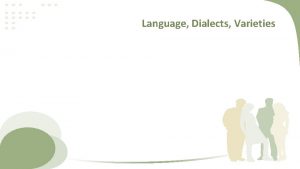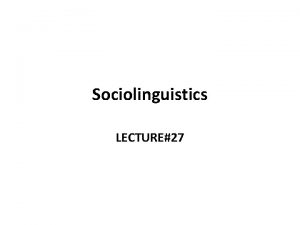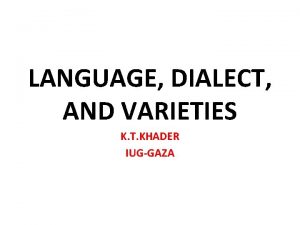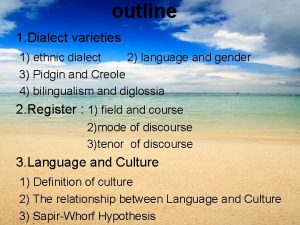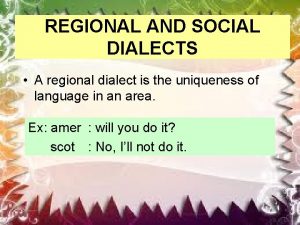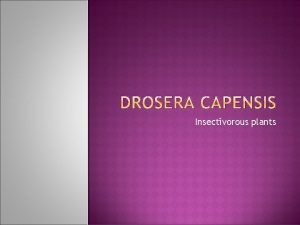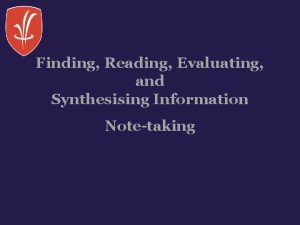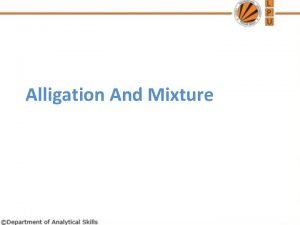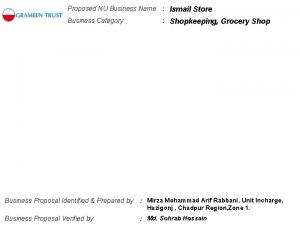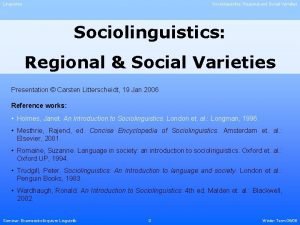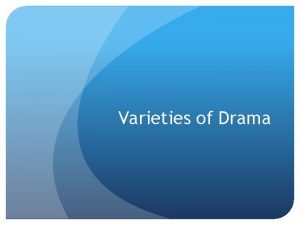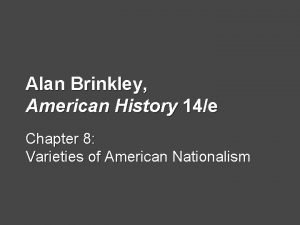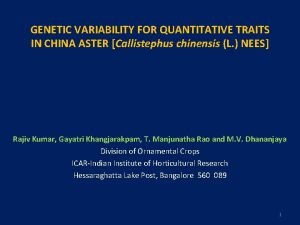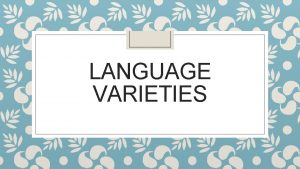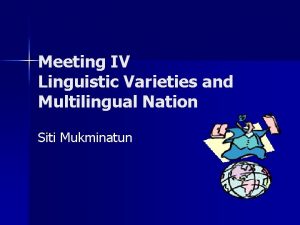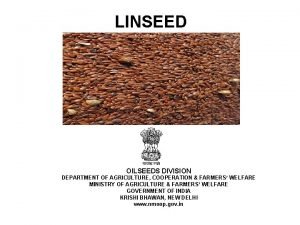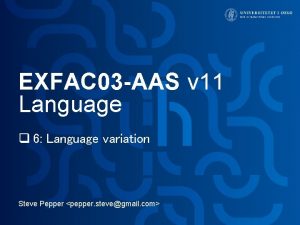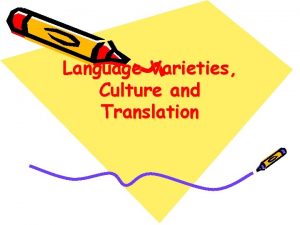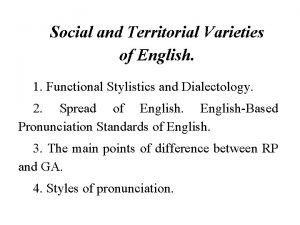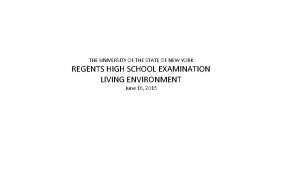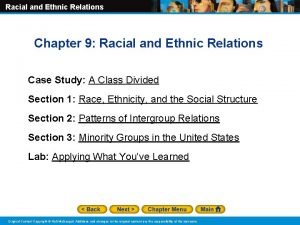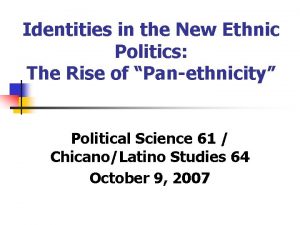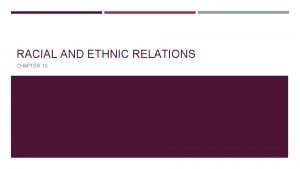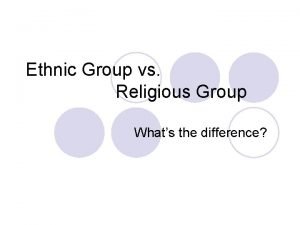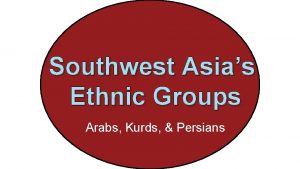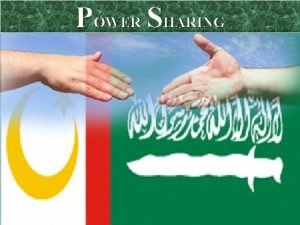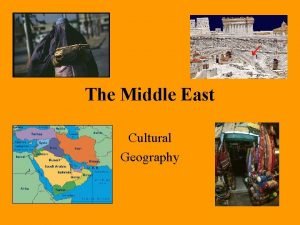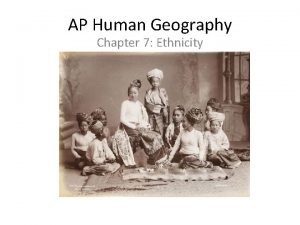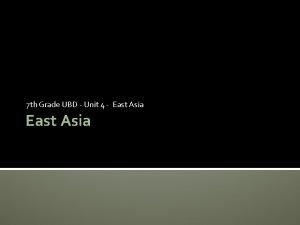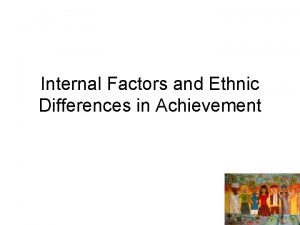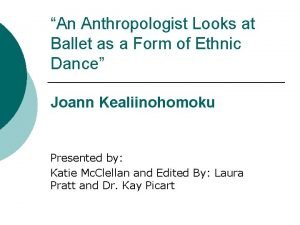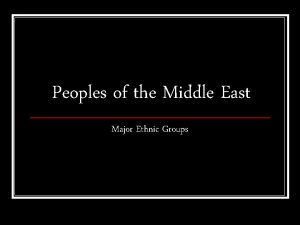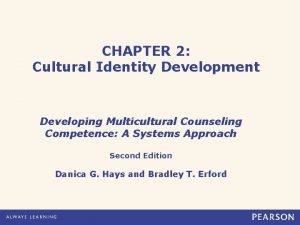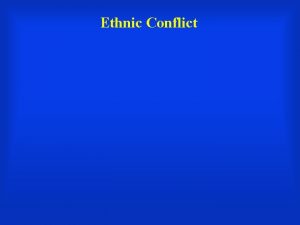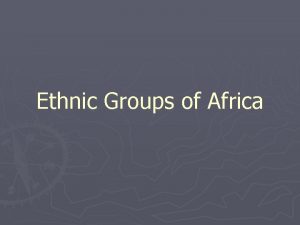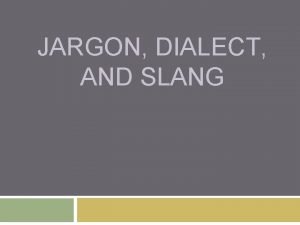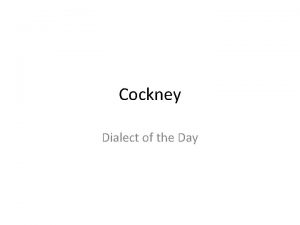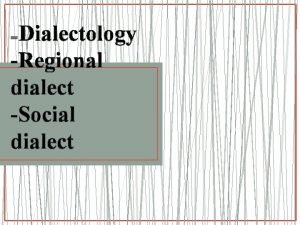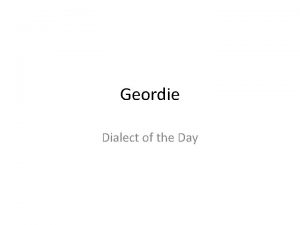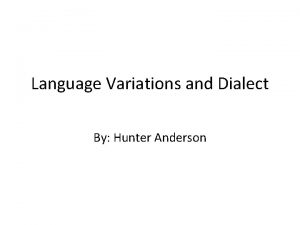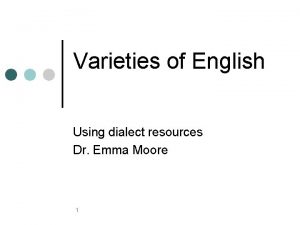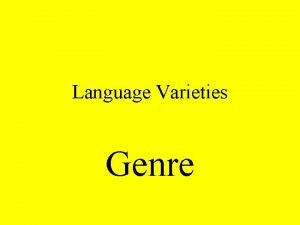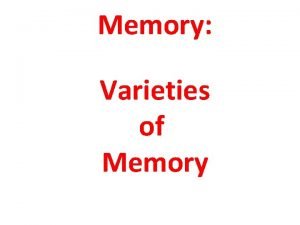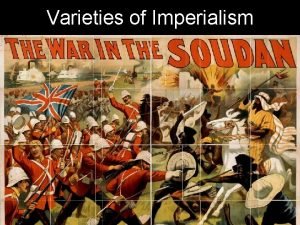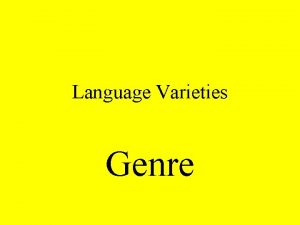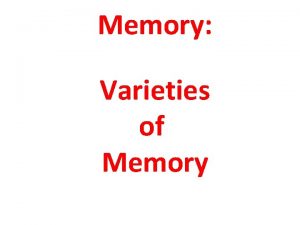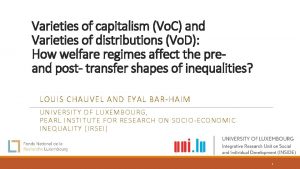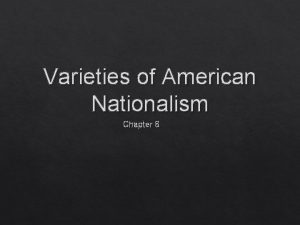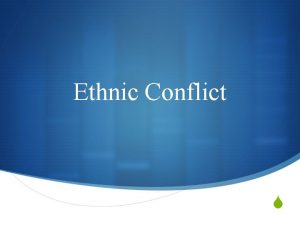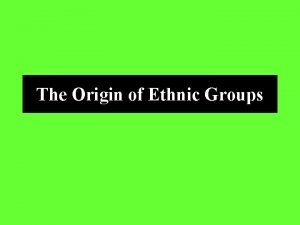outline 1 Dialect varieties 1 ethnic dialect 2











































- Slides: 43

outline 1. Dialect varieties 1) ethnic dialect 2) language and gender 3) Pidgin and Creole 4) bilingualism and diglossia 2. Register : 1) field and course 2)mode of discourse 3)tenor of discourse 3. Language and Culture 1) Definition of culture 2) The relationship between Language and Culture 3) Sapir-Whorf Hypothesis

1. Ethnic Dialect(少数民族方言) • An ethnic dialect is a social dialect of a language that cuts across regional differences, it is mainly spoken by a less privileged population that has experienced some form of social isolation such as racial discrimination or segregation. —何兆熊《新编简明英语语言学教程》P 118

Black English • It is spoken by a large part of American blacks who often have low social status. • It differs from Standard American English (SAM) in rules that are similar to the rules of other language varieties. • It has a portion of vocabulary of its own. • It has a few distinctive phonological, morphological, and syntactic features.

1)A prominent phonological feature of Black English is the simplification of consonant clusters at the end of a word. 就语音而言,最为显著的语音特征是对词尾的辅音连缀进行简化 e. g. passed mend desk told SAM / p ɑ: s t / / mend / / desk / / t ə ʊ ld / B. E / p ɑ: s / / men / / des / / t ə ʊ l/

2)The morphological feature e. g. 1. er → a nigger ------ nigga player ------ playa 2. Kx / cks → x thanks ------ thanx checks ------ chex

3)The differences between the Black English and the standard form exist not only in phonology but also in syntax. 3. 1 ASM There is → B. E It is e. g. Is it a Mr. Smith in this office? Is there a Mr. Smith in this office?

3. 2 It has often cited to show its illogicality is the deletion of the link verb “be”. e. g. B. E ASM He nice. → He is nice. They mine. → They are mine. That house big. → That house is big.

3. 3 Black English uses double negation constructions. 黑人英语中的双重否定结构也是有体系的:当一个动词被 否定时,句中的 any → no anything → nothing anywhere → nowhere … e. g. B. E He don’t know nothing. Tom don’t ever go nowhere. I ain’t afraid of no devils. ASM → → → He doesn’t know anything. Tom never goes anywhere. I am not afraid of any devils.

2. Language and gender • It is interesting to know that the language used by men and women have some special features of their own. —何兆熊《新编简明英语语言学教程》P 116 1). Gender differentiation is reflected in the use of certain lexical items.

Women’s words are expressive adjectives that n covey approval or admiration. Men are much more likely to phrase their approval or liking by using a neutral adjective adorable charming cute sweet fantastic fine good great

• Female speech is more polite than male speech. ↓ e. g. syntactic forms I’m afraid… I’m not sure but… • Male speech , if necessary, tends to use an adverb as damn to reinforcing the adjectives. ↓ e. g. That was a damn good show.

2). Male and female speeches are also found to be different in the use of intonations. - The female speakers tend to have a wider range in their intonation. This makes their speech sound somewhat effected. - Female speakers are heard to use the low-rise intonation with statements much more frequently than male speakers. — 何兆熊《新编简明英语语言学教程》P 116

3. Language and age • It has been noticed that in many communities the language used by the old generation differs from that used by the younger generation in certain ways. —何兆熊《新编简明英语语言学教程》P 117

3. 1. • The most striking difference is found at the lexical level. • Lexical variation is more noticeable across three-generation time span than twogeneration time span. e. g. old generation younger generation icebox fridge wireless boombox

3. 2. On the sentence level, younger women appear to use tag questions much less frequently than old women. e. g. It’s a nice day today, isn’t it ? ( by old women) • avoid assertiveness • make a friendly conversation • offering the opportunity to respond

3. 3. The causes of such differentiation are complex. The root cause is that society is changing different social attitudes different Value judgments

• In general, old people tend to be more conservative than the younger generation in their speech habits, and feel more at home using old words, and less ready to incorporate new terms in to their vocabulary. —何兆熊《新编简明英语语言学教程》P 117

4. 1 Pidgin(洋泾浜) • A pidgin is a special language variety that mixes or blends languages and it is used by people who speak different languages for restricted purposes such as trading. ——何兆熊《新编简明英 语语言学教程》P 124


4. 2 Creole(克里奥尔语) • When a pidgin has become the primary language of a speech community , and is acquired by the children of that speech community as their native language, it is said to have become a Creole. 1). The structure of the original pidgin is expended to enable it to fulfill its new functions. 2). The vocabulary is vastly enriched, and new syntactic-semantic concepts developed. ——何兆熊《新编简明英语语言学教程》P 124


Notable examples. 1). French-based Creole of Haiti的官方语言为法语和克里奥尔语,90%的居民使用克里奥尔语。 2). English-based Creole of Jamaica 1655年被英国占领,1962年 8月6日牙买加宣告独立,1866年成为英直 辖殖民地,现为英联邦成员国。 Pidgin - limited vocabulary - reduced grammatical structure - trading , employment, mission Creole - vast vocabulary - complex grammar - native language / official language

5. Bilingualism and diglossia 5. 1. Bilingualism It has been observed that in some speech communities, two languages are used side by side with each having a different role to play; and language switching occurs when the situation changes. ------ This constitutes the situation of bilingualism. —何兆熊《新编简明英语语言学教程》P 124

e. g. Spanish Paraguay 巴拉圭 Guarani A high percentage of the population know and use both.

5. 1. 1. Rubin(1968) defines 5 major variables to be considered in predicting language usage in Paraguay : 1). location of the interaction 2). formality-informality of the interaction 3). degree of intimacy of the speakers 4). degree of seriousness of the discourse 5). sex of the participants

5. 1. 2. • A typical example of a bilingual community is an ethnic ghetto where most of the inhabitants are either immigrants or children of immigrants. • Bilingualism also occurs in countries and regions with substantial populations speaking different languages and with the need for more than one standard language. —何兆熊《新编简明英语语言学教程》P 125

a typical example : French Canada Belgium English Australia,Singapore Switzerland,Pakistan Uganda,and part of U. S. A Flemish Dutch

5. 2. Diglossia • The term diglossia, first used by Ferguson in 1959, refers to a sociolinguistic situation similar to by bilingualism. • But instead of two different languages , in a diglossic situation two varieties of a language exist side by side throughout the community, with each having a definite role to play.

5. 2. 1. • Each of these languages has two varieties: the high variety (H) and the low variety (L). e. g. High Low Arabic classical colloquial Haitian French Creole Swiss German Hochdeutsch Schweizerdeutsch

5. 2. 2. • One of the most important features of diglossia is the specialization of function of the two varieties. • Ferguson gives a sample listing of possible situations and the variety normally used:

High Low Sermon in church or mosque Instructions to servants, waiters, workmen, clerk Personal letter Speech in parliament, political speech University lectures Conversation with family, friends News broadcast Poetry Folk literature + + + + +

Register(语域) • Definition The type of language which is selected as appropriate to the type of situation is a register. • e. g. 1): A physician may use technical terms when he is talking with his fellow physicians, but he may use ordinary vocabulary when he is talking to his patients.

• e. g. 2): When talking about salt, a chemist may use “Na. Cl” in writing, but he may use the word “salt” before a preschool child. • Registers vary according to the three parameters of context: field, tenor and mode. (Halliday, 1978) Field of discourse(话语范围) Register Tenor of discourse(话语意旨) Mode of discourse(话语方式)

• 1)Field of discourse(话语范围) It involves what is happening, the nature of the social action that is taking place and what the participants are engaged in. • e. g. China (Chinese) America (English) Japan (Japanese) France (French)

• 2)Tenor of discourse(话语意旨) It involves who is taking part, the nature of the participants, their status and roles, and the type of role relationship between the participants. e. g. Teachers---Students Doctors---Patients Parents---Children ●

• 3)Mode of discourse(话语方式) It refers to the means of communication. • e. g. oral writing listening…. • For example: In our class, the communication that is taking place can be analyzed in terms of these dimensions. Field: Linguistic Tenor: Teacher---Student Mode: Oral

Language and culture(语言与文化 ) • 1. Definition of culture(定义) • 1). In a broad sense: It means the total way of life of a people, including the patterns of beliefs, customs, objects, institutions, techniques and language that characterizes the life of the human community.

• 2). In a narrow sense: Culture may refer to local or specific practice, beliefs or customs, which can be mostly found in folk culture, enterprise culture or food culture etc. iceberg

• 2. The relationship between language and culture. (语言与文化的关系) • 1)The language and culture are related that you can not understand or appreciate one without the other. • 2)Every language is part of a culture and it serves and reflects cultural needs. • 3)Language is only the carrier of culture.

• 3. Sapir—Whorf Hypothesis(萨丕尔—沃尔夫假 说) • This interdependence of language and thought is now known as Sapir—Whorf Hypothesis (SWH). Linguistic determinism Strong (语言决定论) Weak • Sapir—Whorf Hypothesis Linguistic relativity (语言相关性)

• 1). Linguistic determinism(语言决定论) It refers to the idea that the language we use to some extent determines the way in which we view and think about the world around us. • a. Strong determinism The language patterns determine people’s thinking and behaviour. • b. Weak determinism The language patterns influence people’s thinking and behaviour.

• 2)Linguistic relativity(语言相关性) Different languages offer people different ways of expressing the world around, they think and speak differently, this is also known as linguistic relativity. World Chinese Japanese

Thanks!
 Language
Language Bell's seven criteria for language
Bell's seven criteria for language Language dialect and varieties
Language dialect and varieties Nigga
Nigga Social dialect vs regional dialect
Social dialect vs regional dialect Language
Language Regional dialect and social dialect
Regional dialect and social dialect Drosera capensis varieties
Drosera capensis varieties Synthesising information
Synthesising information A grocer mixes 21 kg of pulses
A grocer mixes 21 kg of pulses Ismail varieties store
Ismail varieties store Regional variation in sociolinguistics
Regional variation in sociolinguistics Varieties of drama
Varieties of drama Chapter 8 varieties of american nationalism
Chapter 8 varieties of american nationalism Uses of suspension therapy
Uses of suspension therapy Are slices cut horizontally forming a large fish?
Are slices cut horizontally forming a large fish? Iihr china aster varieties
Iihr china aster varieties Variety refers to
Variety refers to Linguistic varieties and multilingual nations
Linguistic varieties and multilingual nations Chapter 6 varieties of drama
Chapter 6 varieties of drama Types of terminations
Types of terminations Rice photos
Rice photos Exfac
Exfac Varieties of culture
Varieties of culture Social varieties of english
Social varieties of english This ameba would most likely be classified as a
This ameba would most likely be classified as a Sandwich sentences
Sandwich sentences Ethnic
Ethnic Pan ethnic
Pan ethnic Timid bigot example
Timid bigot example Ethnic groups coat of arms
Ethnic groups coat of arms Whats ethnic group
Whats ethnic group Southwest asia ethnic groups
Southwest asia ethnic groups Dominant minority
Dominant minority Ethnic groups cloze notes 1 answer key
Ethnic groups cloze notes 1 answer key Relative location of madrid spain
Relative location of madrid spain Power sharing among different social groups in india
Power sharing among different social groups in india Ethnic groups in the middle east
Ethnic groups in the middle east Blockbusting ap human geography definition
Blockbusting ap human geography definition Whats ethnic group
Whats ethnic group Ethnocentric curriculum
Ethnocentric curriculum An anthropologist looks at ballet as a form of ethnic dance
An anthropologist looks at ballet as a form of ethnic dance What are the major ethnic groups in the middle east
What are the major ethnic groups in the middle east Cultural identity development models
Cultural identity development models
